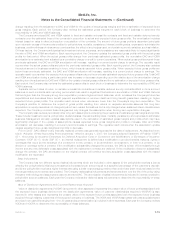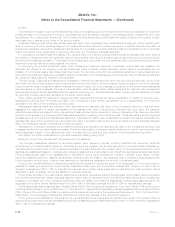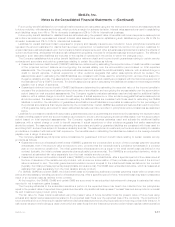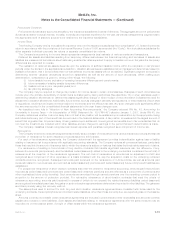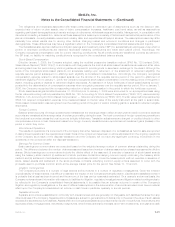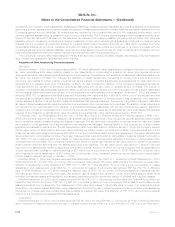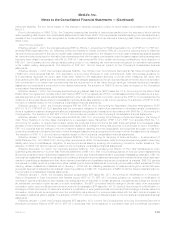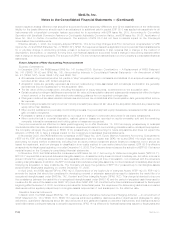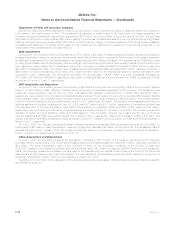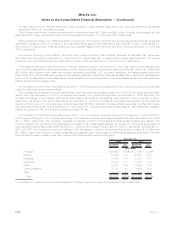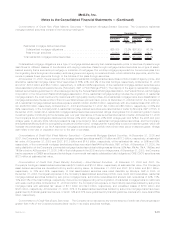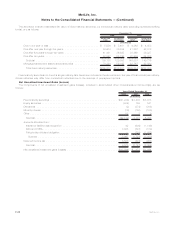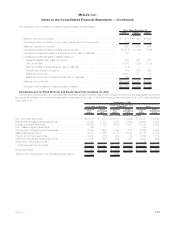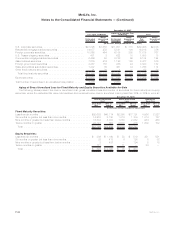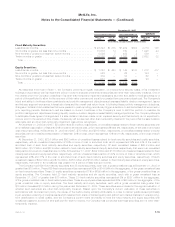MetLife 2008 Annual Report Download - page 148
Download and view the complete annual report
Please find page 148 of the 2008 MetLife annual report below. You can navigate through the pages in the report by either clicking on the pages listed below, or by using the keyword search tool below to find specific information within the annual report.retirement-eligibility. The pro forma impact of this change in expense recognition policy for stock-based compensation is detailed in
Note 18.
Prior to the adoption of SFAS 123(r), the Company presented tax benefits of deductions resulting from the exercise of stock options
within operating cash flows in the consolidated statements of cash flows. SFAS 123(r) requires tax benefits resulting from tax deductions in
excess of the compensation cost recognized for those options be classified and reported as a financing cash inflow upon adoption of
SFAS 123(r).
Other Pronouncements
Effective January 1, 2008, the Company adopted FSP No. FIN 39-1, Amendment of FASB Interpretation No. 39 (“FSP 39-1”). FSP 39-1
amends FASB Interpretation No. 39, Offsetting of Amounts Related to Certain Contracts (“FIN 39”), to permit a reporting entity to offset fair
value amounts recognized for the right to reclaim cash collateral (a receivable) or the obligation to return cash collateral (a payable) against
fair value amounts recognized for derivative instruments executed with the same counterparty under the same master netting arrangement
that have been offset in accordance with FIN 39. FSP 39-1 also amends FIN 39 for certain terminology modifications. Upon adoption of
FSP 39-1, the Company did not change its accounting policy of not offsetting fair value amounts recognized for derivative instruments
under master netting arrangements. The adoption of FSP 39-1 did not have an impact on the Company’s consolidated financial
statements.
Effective January 1, 2008, the Company adopted SAB No. 109, Written Loan Commitments Recorded at Fair Value through Earnings
(“SAB 109”), which amends SAB No. 105, Application of Accounting Principles to Loan Commitments. SAB 109 provides guidance on
(i) incorporating expected net future cash flows when related to the associated servicing of a loan when measuring fair value; and
(ii) broadening the SEC staff’s view that internally-developed intangible assets should not be recorded as part of the fair value of a derivative
loan commitment or to written loan commitments that are accounted for at fair value through earnings. Internally-developed intangible
assets are not considered a component of the related instruments. The adoption of SAB 109 did not have an impact on the Company’s
consolidated financial statements.
Effective January 1, 2008, the Company adopted Emerging Issues Task Force (“EITF”) Issue No. 07-6, Accounting for the Sale of Real
Estate When the Agreement Includes a Buy-Sell Clause (“EITF 07-6”) prospectively. EITF 07-6 addresses whether the existence of a buy-
sell arrangement would preclude partial sales treatment when real estate is sold to a jointly owned entity. EITF 07-6 concludes that the
existence of a buy-sell clause does not necessarily preclude partial sale treatment under current guidance. The adoption of EITF 07-6 did
not have a material impact on the Company’s consolidated financial statements.
Effective January 1, 2007, the Company adopted FSP No. EITF 00-19-2, Accounting for Registration Payment Arrangements (“FSP
EITF 00-19-2”). FSP EITF 00-19-2 specifies that the contingent obligation to make future payments or otherwise transfer consideration
under a registration payment arrangement should be separately recognized and measured in accordance with SFAS No. 5, Accounting for
Contingencies. The adoption of FSP EITF 00-19-2 did not have an impact on the Company’s consolidated financial statements.
Effective January 1, 2007, the Company adopted FSP No. FAS 13-2, Accounting for a Change or Projected Change in the Timing of
Cash Flows Relating to Income Taxes Generated by a Leveraged Lease Transaction (“FSP 13-2”). FSP 13-2 amends SFAS No. 13,
Accounting for Leases, to require that a lessor review the projected timing of income tax cash flows generated by a leveraged lease
annually or more frequently if events or circumstances indicate that a change in timing has occurred or is projected to occur. In addition,
FSP 13-2 requires that the change in the net investment balance resulting from the recalculation be recognized as a gain or loss from
continuing operations in the same line item in which leveraged lease income is recognized in the year in which the assumption is changed.
The adoption of FSP 13-2 did not have a material impact on the Company’s consolidated financial statements.
Effective January 1, 2007, the Company adopted SFAS No. 156, Accounting for Servicing of Financial Assets — an amendment of
FASB Statement No. 140 (“SFAS 156”). Among other requirements, SFAS 156 requires an entity to recognize a servicing asset or servicing
liability each time it undertakes an obligation to service a financial asset by entering into a servicing contract in certain situations. The
adoption of SFAS 156 did not have an impact on the Company’s consolidated financial statements.
Effective November 15, 2006, the Company adopted SAB No. 108, Considering the Effects of Prior Year Misstatements when
Quantifying Misstatements in Current Year Financial Statements (“SAB 108”). SAB 108 provides guidance on how prior year misstatements
should be considered when quantifying misstatements in current year financial statements for purposes of assessing materiality. SAB 108
requires that registrants quantify errors using both a balance sheet and income statement approach and evaluate whether either approach
results in quantifying a misstatement that, when relevant quantitative and qualitative factors are considered, is material. SAB 108 permits
companies to initially apply its provisions by either restating prior financial statements or recording a cumulative effect adjustment to the
carrying values of assets and liabilities as of January 1, 2006 with an offsetting adjustment to retained earnings for errors that were
previously deemed immaterial but are material under the guidance in SAB 108. The adoption of SAB 108 did not have a material impact on
the Company’s consolidated financial statements.
Effective January 1, 2006, the Company adopted prospectively EITF Issue No. 05-7, Accounting for Modifications to Conversion
Options Embedded in Debt Instruments and Related Issues (“EITF 05-7”). EITF 05-7 provides guidance on whether a modification of
conversion options embedded in debt results in an extinguishment of that debt. In certain situations, companies may change the terms of
an embedded conversion option as part of a debt modification. The EITF concluded that the change in the fair value of an embedded
conversion option upon modification should be included in the analysis of EITF Issue No. 96-19, Debtor’s Accounting for a Modification or
Exchange of Debt Instruments, to determine whether a modification or extinguishment has occurred and that a change in the fair value of a
conversion option should be recognized upon the modification as a discount (or premium) associated with the debt, and an increase (or
decrease) in additional paid-in capital. The adoption of EITF 05-7 did not have a material impact on the Company’s consolidated financial
statements.
Effective January 1, 2006, the Company adopted EITF Issue No. 05-8, Income Tax Consequences of Issuing Convertible Debt with a
Beneficial Conversion Feature (“EITF 05-8”). EITF 05-8 concludes that: (i) the issuance of convertible debt with a beneficial conversion
F-25MetLife, Inc.
MetLife, Inc.
Notes to the Consolidated Financial Statements — (Continued)


